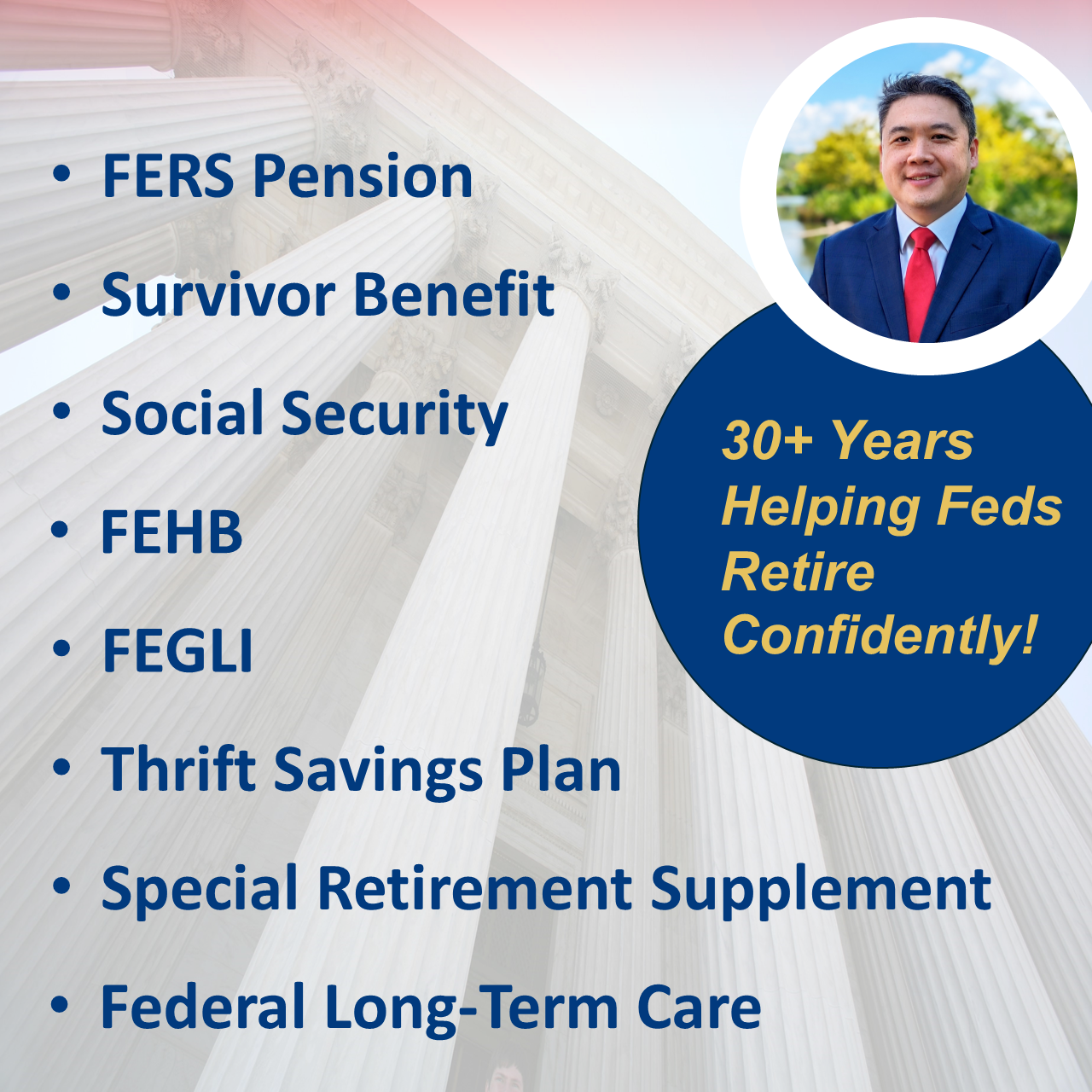FERS retirement from federal government information. Learn how sick leave impacts your benefits and the 1.1% rule. Use our calculator for precise federal employee retirement planning.
FERS Retirement Calculator: Estimate Your Future Pension Today and Don’t Miss this Misunderstood Rule
When it comes to federal employee retirement benefits, “simple” is not the word one uses often. Knowing the differences between FERS and CSRS, the eligibility rules for each, and understanding different types of service and occupations in the federal space is complicated enough, and that’s before throwing in the intricacies of TSP management, Social Security benefits, and healthcare (FEHB) and life insurance (FEGLI). Along with reviewing some basic information about FERS eligibility in this article, we’ll also review an often misunderstood rule regarding unused sick leave and the 10% pension boost feds can expect if retiring after age 62 with at least 20 years.
Need to estimate your income in retirement? Try our free online calculator for FERS.
Unused Sick Leave and the 10% Boost to FERS after the Age of 62
Retire at 60 versus 62: Immediate Retirement Eligibility and the 1.1% Multiplier
For information about non-immediate pension options, check out this article about postponed and deferred retirement under FERS. The 10% boost to one’s federal pension is only accessible to those who retire under FERS with an immediate non-disability pension, and is not available for special provision employees as they are required to leave federal service before turning even 60. As a refresher, to be eligible for an immediate full pension from the federal government under FERS, you must meet the following age and years of service requirements:
- At least MRA (minimum retirement age, between 55 and 57) with at least 30 years
- Age 60 with 20 or more years
- Age 62 with at least 5 years
On top of that, if your retire after age 62 with 20 years of service, your annuity computation will use a 1.1 percent multiplier instead of the standard 1.0% – essentially adding 10% to the annual gross amount. Retiring early at 60 with at least 10 years of service (but less than 20) entails not only forgoing the extra boost, but also a steep age reduction penalty resulting in a reduced pension.
Check out our free FERS Handbook for more information about your Federal Employee Benefits
How Unused Sick Leave Impacts Your Retirement Calculation
Unused sick leave is added to one’s years of service when calculating a FERS annuity and it is common knowledge that this extra amount counts toward the pension’s dollar amount but not towards retirement eligibility. So basically, if you have enough sick leave accumulated to add 2 years to your computation, and you are age 60 with 18 years of service, a total of 20 years will be used when your personnel office computes your annuity amount. However, this extra 2 years would not be factored in when determining eligibility for an unreduced pension (you would still be subject to a 10% age-based reduction, which is permanent.) Because of this, a lot of federal employees assume the same goes for eligibility to utilize the 1.1% multiplication factor – but as confirmed by this 2018 memo from OPM – if there is enough sick leave to push a federal employee’s service years above the necessary 20 year threshold, and they are retiring at age 62 or older, then they are entitled to the 10% boost! This is because OPM already considers them eligible for retirement as they have at least five years of service.
Figure out how your accumulated unused sick leave will increase your pension with our free FERS sick leave conversion tool.
What it All Means: Unpacking this Often Overlooked Rule
Knowing that sick leave can make one eligible for the 10% boost might be a gamechanger for a federal employee’s retirement plan. It might also give cause to reconsider how one “leverages their leave.” There are strategies out there that suggest using sick leave in lieu of annual leave in order to boost the lump-sum payout received for unused annual leave, and there are other methods of thinking that suggest the opposite – exhausting the annual leave supply before tapping into sick leave in order to increase a retiree’s pension. If adhering to either strategy or neither, knowing that unused sick leave can allow you to retire sooner with the 10% annuity boost might drastically shift how a federal worker approaches their management of paid time off.
Learn more about your pension at our online federal retirement seminars.
How Does the FERS Retirement Calculator Work?
What Information Do You Need to Use the Calculator?
To effectively use the FERS retirement calculator, you need to input specific information about your federal service. This includes your years of service, your high-3 salary (which can be computed on the same page as the calculator), and your age at retirement. The high-3 average salary is the highest average basic pay you earned during any three consecutive years of federal service. Additionally, you should know your minimum retirement age (MRA), which varies based on your birth year. Having this information at hand will allow the calculator to provide a more accurate estimate of your FERS pension.
How to Calculate Your FERS Annuity
The calculation of your FERS annuity is based on a formula that considers your years of creditable service and your high-3 average salary. For most federal employees, the formula is 1% of your high-3 average salary multiplied by your length of service in years. However, if you retire at age 62 or older with at least 20 years of service (including unused sick leave!), the formula increases to 1.1% (increasing the gross amount by 10%). This calculation provides an estimate of your annual pension income upon retirement. It’s important to remember that this is a simplified explanation, and other factors such as early retirement penalties or additional contributions may affect the final amount.
What Are the Key Components of the FERS Retirement Plan?
Understanding the FERS Annuity and Deposits
The FERS annuity is a cornerstone of the federal retirement plan, providing a steady stream of income for retirees. It is designed to replace a portion of your pre-retirement income and is calculated based on your years of service and salary history. The annuity is a defined benefit, meaning it is a guaranteed payment for life, adjusted for inflation. Understanding how your annuity is calculated and how it fits into your overall retirement strategy is crucial for effective planning. Military service and other service can add to one’s pension if they make a deposit or redeposit – which is typically worth it in the long haul. But making these deposits early can save you money because the amount due is plus interest after 3 years of employment – so don’t wait until you’re putting your retirement paperwork together!
When Can Federal Employees Retire Under FERS?
What Are the Penalties for Early Retirement?
Retiring before meeting the age and service requirements can lead to penalties that reduce your FERS pension. If you retire before reaching your MRA or without sufficient years of service, your annuity may be subject to a reduction. This reduction is typically 5% for each year you retire before age 62. Understanding these penalties is crucial for making informed decisions about when to retire and how to maximize your retirement benefits.
How Can a Financial Advisor Assist in Retirement Planning?
A financial advisor can be an invaluable resource in planning for retirement under FERS. They can help you understand the complexities of the FERS retirement system and develop a personalized retirement strategy. A financial advisor can assist in optimizing your TSP contributions, evaluating the impact of Social Security benefits, and exploring options for deferred or disability retirement. Their expertise can help you make informed decisions and ensure you’re on track to achieve your retirement goals.
You’ve got to see what makes PlanWell Financial different than other financial firms.
What Are the Differences Between FERS and CSRS?
How Do the Retirement Benefits Compare?
The Federal Employees Retirement System (FERS) and the Civil Service Retirement System (CSRS) are two distinct retirement plans for federal employees. FERS is a three-tiered system that includes the FERS annuity, Social Security, and the Thrift Savings Plan, providing a comprehensive retirement package. In contrast, CSRS is a single-tiered system that offers a higher annuity but does not include Social Security benefits. Understanding the differences in retirement benefits between FERS and CSRS is crucial for federal employees transitioning between the two systems or evaluating their retirement options.
Reach Out to Us!
If you have additional federal benefit questions, contact our team of CERTIFIED FINANCIAL PLANNER™ (CFP®), Chartered Federal Employee Benefits Consultants (ChFEBC℠), and Accredited Investment Fiduciary (AIF) professionals. At PlanWell, we are federal employee financial advisors with a focus on retirement planning. Learn more about our process designed for the career fed.
Preparing for federal retirement? Check out our scheduled federal retirement workshops. Sign up for our no-cost federal retirement webinars here! Make sure to plan ahead and reserve your seat for our FERS webinar, held every three weeks. Want to have PlanWell host a federal retirement seminar for your agency? Reach out, and we’ll collaborate with HR to arrange an on-site FERS seminar.
Want to fast-track your federal retirement plan? Skip the FERS webinar and start a one-on-one conversation with a ChFEBC today. You can schedule a one-on-one meeting here.










